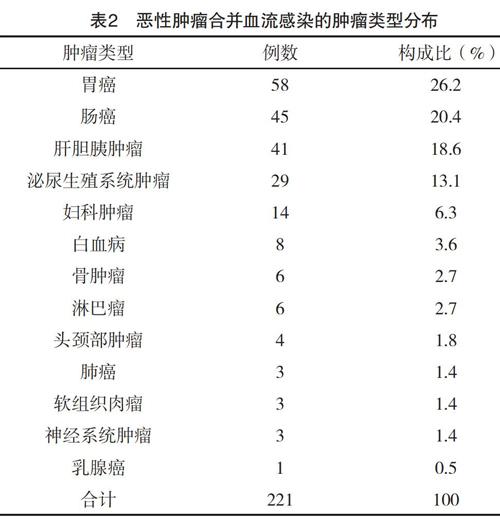恶性肿瘤合并血流感染的临床特点
吴春兰



【摘要】目的:研究恶性肿瘤合并血流感染患者的临床特征,为临床治疗提供参考。方法:选取2013-2017年本院恶性肿瘤合并血流感染患者221例。分析患者临床资料、肿瘤类型、致病菌及其药敏结果、转归情况。结果:本组男151例、女70例,死亡36例(16.3%),60岁以上老年人、低蛋白血症、貧血、TNM中晚期(Ⅲ、Ⅳ期)者较多。221例患者中最常见消化道肿瘤,占65.2%。共培养出病原菌237株,革兰阴性菌149株(62.9%)、革兰阳性菌73株(30.8%)、真菌15株(6.3%)。革兰阴性菌中大肠埃希菌占比最高(25.7%),对哌拉西林、氨苄西林、氨苄西林/舒巴坦耐药率最高(100%);肺炎克雷伯菌占比10.1%,对氨苄西林、哌拉西林耐药率较高,分别为100%、95.8%;鲍曼不动杆菌占比7.2%,对氨曲南耐药率最高(52.9%)。革兰阳性菌以表皮葡萄球菌、金黄色葡萄球菌为主,分别占7.6%、6.3%,对青霉素G耐药率最高,分别为83.3%、86.7%。真菌中白色念珠菌占比最高(4.2%)。结论:在恶性肿瘤患者的治疗过程中,应减少有创操作,严格无菌操作,预防血流感染的发生;同时恶性肿瘤患者合并血流感染以革兰阴性菌为主,临床应合理规范使用抗生素以提高疗效。
【关键词】恶性肿瘤;血流感染;革兰阴性菌
Clinical Characteristics of Malignant Tumors Complicated with Bloodstream Infection/WU Chunlan.//Medical Innovation of China,2019,16(27):-172
【Abstract】Objective:To study the clinical characteristics of patients with malignant tumors complicated with bloodstream infection,and to provide reference for clinical treatment.Method:A total of 221 patients with malignant tumors complicated with bloodstream infection in our hospital from 2013 to 2017 were selected.The clinical data,types of tumors,pathogenic bacteria,results of drug sensitivity and prognosis of the patients were analyzed.Result:There were 151 males and 70 females in this group,and 36 cases(16.3%)died.Patients who were over 60 years old or in advanced stage(stage Ⅲ,Ⅳ)or those who developed hypoproteinemia or anemia were more common.Tumors of the digestive system were the most common,accounted for 65.2%.A total of 237 strains of pathogenic bacteria were cultured,149 strains(62.9%)of Gram-negative bacteria,73 strains(30.8%)of Gram-positive bacteria and 15 strains(6.3%)of fungi.Escherichia coli accounted for the highest proportion of Gram-negative bacteria(25.7%)and the highest resistance rates to Piperacillin,Ampicillin and Ampicillin/Sulbactam(100%),Klebsiella pneumoniae accounted for 10.1%,the resistance rates to Ampicillin and Piperacillin were 100% and 95.8% respectively,Acinetobacter baumannii accounted for 7.2%,and the drug resistance rate to Aztreonam was the highest(52.9%).Staphylococcus epidermidis and Staphylococcus aureus were the main Gram-positive bacteria,accounting for 7.6% and 6.3% respectively,the resistance rate to penicillin G was the highest,83.3% and 86.7% respectively.Candida albicans accounted for the highest proportion of fungi(4.2%).Conclusion:In the treatment of malignant tumors,we should reduce invasive operation,strictly aseptic operation and prevent the occurrence of bloodstream infection,at the same time,Gram-negative bacteria are the main pathogens of bloodstream infection in malignant tumors,so antibiotics should be used reasonably and regularly in clinic to improve the curative effect.
本研究革兰阴性菌中,大肠埃希菌对哌拉西林/他唑巴坦钠、碳青霉烯类(亚胺培南、美罗培南)耐药率最低(13.1%),肺炎克雷伯菌对哌拉西林/他唑巴坦钠、碳青霉烯类(亚胺培南、美罗培南)均敏感,鲍曼不动杆菌对阿米卡星耐药率最低(5.9%)。革兰阳性菌以表皮葡萄球菌、金黄色葡萄球菌为主,对青霉素G、苯唑西林等常用抗菌药物的耐药率均高于50.0%,对万古霉素、利奈唑胺均敏感,与其他报道一致[10-12],提示血流感染中表皮葡萄球菌与金黄色葡萄球菌对常用的抗菌药物耐药率较高,与其具有耐药基因、β-内酰胺酶、主动外排系统、DNA旋转酶靶位改变和产生生物膜、合成青霉素结合蛋白等耐药机制相关[11-15],临床上可根据以上药敏选择抗生素。本研究中真菌构成比为6.3%,以白色念珠菌为主,与文献[16-17]报道一致。白色念珠菌的感染多为内源性感染,白念珠菌性血流感染较多发生在胃肠道肿瘤患者中,肿瘤患者在接受各种有创治疗后,胃肠道黏膜极其脆弱,容易使定植菌移位入血造成感染[18-20];合并真菌感染后死亡风险较高[5,17],临床上抗真菌治疗时,应重点覆盖白色念珠菌。
综上所述,恶性肿瘤合并血流感染病死率高,在临床工作中,应充分评估留置导管的必要性,尽量减少创伤性操作,同时应注意严格无菌操作,缩短中心静脉导管留置时间,避免导管相关性感染的发生;另一方面,早期多次进行血培养,尽早获得病原菌及药敏结果,在经验性抗感染治疗,应着重覆盖如大肠埃希菌、肺炎克雷伯菌等革蘭阴性菌,再根据药敏结果重新评估与调整用药,以提高治疗效果,改善预后。
参考文献
[1]徐海燕,王延风,冯莎娜,等.恶性肿瘤患者血流感染的危险因素分析[J].中华医院感染学杂志,2016,26(5):1014-1016.
[2]中华人民共和国卫生部.医院感染诊断标准(试行)[J].中华医学杂志,2001,81(5):314-320.
[3] Rajendran R,Sherry L,Nile C J,et al.Biofilm formation is a risk factor for mortality in patients with Candida albicans bloodstream infection-Scotland,2012-2013[J].Clin Microbiol Infect,2016,22(1):87-93.
[4] López-Cortés L E,Rosso-Fernández C,Nú?ez-Nú?ez M,et al.Targeted simplification versus antipseudomonal broad-spectrum beta-lactams in patients with bloodstream infections due to Enterobacteriaceae(SIMPLIFY):a study protocol for a multicentre,open-label,phase Ⅲ randomized,controlled,non-inferiority clinical trial[J].BMJ Open,2017,7(6):e015439.
[5] Vaquero-Herrero M P,Ragozzino S,Casta?o-Romero F,et al.
The Pitt Bacteremia Score,Charlson Comorbidity Index and Chronic Disease Score are useful tools for the prediction of mortality in patients with Candida bloodstream infection[J].Mycoses,2017,60(10):676-685.
[6]徐海燕,刘姗,冯沙娜,等.实体瘤患者发生血流感染的病原学特点及预后分析[J].中华医院感染学杂志,2018,28(8):1158-1161,1174.
[7] Daneman N,Rishu A H,Pinto R,et al.7 versus 14 days of antibiotic treatment for critically ill patients with bloodstream infection:a pilot randomized clinical trial[J].Canadian Critical Care Trials Group,2018,19(1):111.
[8]吕媛,李耘,薛峰,等.卫生部全国细菌耐药监测网(Mohnarin)2011-2012年度血流感染细菌耐药监测报告[J].中国临床药理学杂志,2014,30(3):278-288.
[9]宁立芬,马红玲,汪玉珍.2011-2012年医院感染病原菌分布及耐药性分析[J].中华医院感染学杂志,2014,24(6):1344-1346.
[10]张能华,周铁丽.232例血培养病原菌分布特点及耐药性分析[J].中国微生态学杂志,2015,27(9):1052-1054,1061.
[11]谢朝云,胡阳,杨忠玲,等.血流感染患者表皮葡萄球菌与金黄色葡萄球菌的分布与耐药性分析[J].中国微生态学杂志,2016,28(12):1409-1411,1423.
[12]杭亚平,汪红,宁长秀,等.血流感染葡萄球菌菌种分布及耐药特性分析[J].中国微生态学杂志,2015,27(2):199-202.
[13]李雪寒,李一荣.耐甲氧西林金黄色葡萄球菌耐药机制及检测方法研究进展[J].国际检验医学杂志,2019,40(5):586-589.
[14]谢朝云,闫飞,熊永发,等.骨科感染葡萄球菌属细菌临床分布与耐药性分析[J].中国微生态学杂志,2014,26(11):1295-1297,1301.
[15]董鹏霞,托娅.金黄色葡萄球菌耐药机制的研究进展[J].内蒙古中医药,2014,33(25):105-106.
[16]李丁,张青,白长森,等.肿瘤患者合并非白念珠菌性血流感染的危险因素分析[J].中华医院感染学杂志,2017,27(6):1240-1243.
[17] González-Lara M F,Torres-González P,Cornejo-Juárez P,et al.
Impact of inappropriate antifungal therapy according to current susceptibility breakpoints on Candida bloodstream infection mortality,a retrospective analysis[J].BMC Infect Dis,2017,17(1):753.
[18] Netea M G,Joosten L A,van der Meer J W,et al.Immune defence against Candida fungal infections[J].Nat Rev Immunol,2015,15(10):630-642.
[19] Alp S,Arikan-Akdagli S,Gulmez D,et al.Epidemiology of Candidaemia in a tertiary care university hospital:10-year experience with 381 candidaemia episodes between 2001 and 2010[J].Mycoses,2015,58(8):498-505.
[20] Yapar N.Epidemiology and risk factors for invasive candidiasis[J].Ther Clin Risk Manag,2014,10:95-105.
(收稿日期:2019-07-11)(本文編辑:董悦)

